Two days a week, José Manuel Mora Velásquez continues a tradition that
has been part of his family for more than 80 years. Long before dawn he
begins preparations for baking pan de tlachigual,
a type of bread so distinctly regional that Sr. Mora says that it has
only been made in San Juan Cosalá and in Ajijic, although it’s sold in
other towns along the north shore of Lake Chapala.
In years gone by, natives of those two towns did not allow a wedding, baptism, First Communion or confirmation to pass without tlachigual
as part of the festivity rituals. Although times are changing, even
today the most traditional celebrations of these life passages include
the humble local loaves.
Sr. Mora showed me around the tiny bakery at his home in
Ajijic. The ceiling is low and the only light comes from windows
without glass. Loaves of freshly baked tlachigual are piled high on a wooden shelf while dough rises in a warm corner, out of the way of any passing breeze.
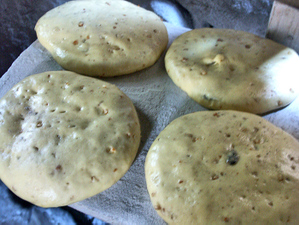
Tlachigual loaves stuffed with nuts and raisins rise on the bakery shelves.
"The oven is heated only by wood. It’s not easy to keep a good supply
of wood, but we collect it from all over the area. People usually tell
me where a dry tree has fallen, or where someone has cut down a tree
that will burn well when the wood is dry."
"Which days of the week do you bake?" I asked.
"Wednesdays, like today, and Saturdays. It’s very time-consuming work and you have to pay very close attention to the masa (dough) or it won’t turn out right." Sr. Mora turned to peer into the oven as he spoke to me.
"A full twenty-four hours before I bake, I have to prepare the harina fermentada (starter).
It’s a mixture of flour and water. I mix that, and then it sits in the
warm bakery for a full day before I can use it for the bread.
"Early in the morning of the days I bake, I mix the dough. It’s
made with the starter dough I made the day before, plus additional
flour, eggs, sugar, and lard. Some of the dough is made with whole
wheat flour and some with white flour. The white flour dough has white
sugar, raisins and toasted nuts blended into it. The whole wheat loaves
are sweetened with piloncillo (cones of brown sugar)."
Sr. Mora showed me how he weighs each of the ingredients to make the
bread. "I don’t measure. The bread is better if each component is
weighed. How many kilos of flour I use depends on how many loaves I
need to bake on any given day. Usually I make enough dough to produce
400 loaves a day.
"Baking this traditional way is different from baking in a modern oven.
The first difference, of course, is that the oven is made of bricks and
clay. It’s shaped like a beehive. And as I said before, I use wood fire
for the heat. Temperature control is more difficult. I have to start
the fire about three hours before the dough starts to bake. That’s so
the oven will reach the right temperature. It takes two hours for the
coals to be at the right stage, then another hour for the temperature
to go down enough so the bread will bake in the right amount of time."
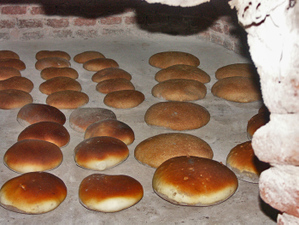
Tlachigual bakes right on the floor of the brick beehive oven.
I looked into the oven, which has no door, and saw that the
baking bread was beginning to turn golden brown. "I don’t see a
thermometer, Sr. Mora. How do you know when the oven has reached the
right temperature to begin baking?"
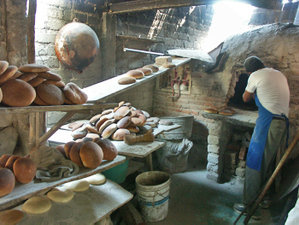
Sr. Mora checks the oven to make sure the temperature is right.
He laughed. "I put one loaf in to bake. It should be ready in
about 30 to 40 minutes. If it takes longer than that, I put more wood
on the fire. If it bakes too quickly, I wait a bit for the temperature
to go down. Then I try again. Of course I’ve been doing this for so
long that I can almost always tell when the temperature is right, but I
still bake a trial loaf to be sure."
I asked Sr. Mora if there were other tlachigual bakers in
Ajijic. "Yes, my cousin still makes this bread the old way. She lives
on Calle Constitución and bakes on Tuesday and Thursday. I think we’re
the only two left in Ajijic who bake this bread. There is a family in
San Juan Cosalá that still has a bakery, but I don’t know them
personally."
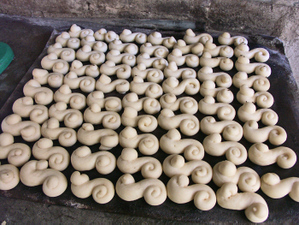
Ojitos (little eyes) rise near the warmth of the oven.
An article about the San Juan Cosalá bakers appeared several years ago in the Lake Chapala Spanish-language weekly newspaper, El Charal. At that time, Sra. Margarita Villalobos and one of her daughters were baking pan de tlachigual for distribution and sale in San Juan, in Nestipac, and in Jocotepec. Sra. Villalobos told El Charal that as a young girl, she had learned to make tlachigual
from her mother. Her methods hadn’t changed over the years, she said,
because making the bread in the traditional way gives it the delicious
flavor that people want. Sra. Villalobos said that someone had offered
her an electric mixer to help beat the dough, but she was not
interested in changing her style of preparation. "Other bakers make it
using the same recipe I do, but they don’t mix it by hand. Their
results aren’t the same," she reported.
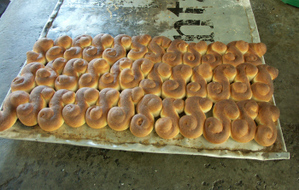
Sr. Mora’s baking sheet is made of a flattened 5-gallon square tin can.
Sr. Mora tells a similar story. "A woman named Teresa taught my aunt how to make tlachigual,
and my aunt taught me," he reminisced. "And now there’s no one left to
teach. My children don’t want to be bakers. It’s sad to think that I
might be the last in the family to keep this tradition alive."
Although Sr. Mora graciously told me about his work and the traditions
of the bread he made, there was never a time when he was not also
paying strict attention to the rising loaves, the bread baking in the
oven, and the bread that was cooling on primitive wooden shelves along
three walls of the bakery. I watched quietly for a while as Sr. Mora
worked.
With one eye on the oven, he picked up an escobilla (double-ended straw brush) and started rhythmically sweeping the wood ash from each cool loaf of tlachigual. As he cleaned each loaf, he placed it in a pile.
When he noticed that the bread inside the oven had turned a deep golden brown, he set aside the escobilla and picked up a pala (literally a shovel, but in this case it resembled a long-handled wooden pizza peel). He used the pala to remove a metal tray holding the ojitos
from the oven and placed it on a table near where I was standing. In
one experienced and skillful motion, he scooped up as many small panes de tlachigual as the pala would hold and transferred them from the oven to a shelf for cooling. With a similar movement, he loaded the pala with unbaked loaves of tlachigual. Gently shoving the pala
as far into the oven as he knew it needed to go so that the bread would
bake evenly, he snapped his elbow back and the raw loaves landed evenly
spaced on the oven floor. In just a few minutes he demonstrated skills
he had acquired over his 22 years as a baker.
The sweet smell of baking tlachigual was making me very
hungry. "Sr. Mora, do you take all of the bread to be sold at stores
here in town?" I was hoping he’d say no, and I was not disappointed.
"A lot of people come here to the bakery to buy bread. And the boys
take some to be sold out on the streets in that washtub…" he gestured
to a galvanized metal tub in the corner by the oven. "And of course
some does go to stores around town."
"What does the tlachigual cost?" I was fingering some coins in my pocket.
"The small loaves are four pesos, the big ones are ten pesos.
And those mini-loaves are two pesos apiece. I sell the miniatures to
mothers for little kids."
I bought four loaves, one large and three small. The large one came
home with me and I took the three small ones to share with my neighbors. My car held the tantalizing scent of the fresh-baked bread for two days.
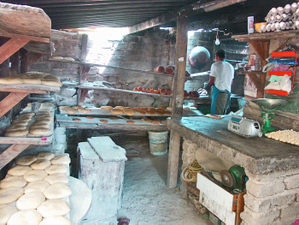

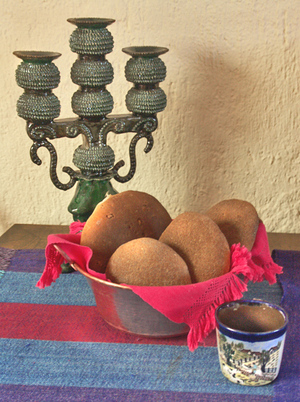
Leave a Reply